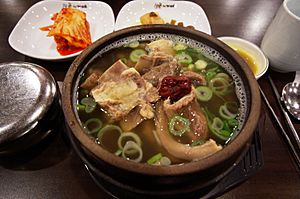Galbi-tang facts for kids
 |
|
| Alternative names | Short rib soup |
|---|---|
| Type | Tang |
| Place of origin | Korea |
| Main ingredients | Short ribs |
| Korean name | |
| Hangul |
갈비탕
|
|---|---|
| Hanja |
--湯
|
| Revised Romanization | galbi-tang |
| McCune–Reischauer | kalbi-t'ang |
| IPA | [kal.bi.tʰaŋ] |
Galbi-tang (갈비탕) is a delicious and hearty Korean soup. It's also known as short rib soup. This soup is made mainly from beef short ribs. It also includes other tasty ingredients like radish and onions.
The word galbi means "short ribs." You might have heard of galbi in Korean barbecue, where it refers to grilled ribs. The word tang is another name for guk, which means "soup" in Korean. So, Galbi-tang literally means "short ribs soup."
This soup is famous for its clear and rich broth. It's made by slowly cooking galbi in water for a long time. People usually eat it as a full meal. It's a bit like seolleongtang, which is another Korean soup made from ox leg bones.
People have been eating galbi since the end of the Goryeo Dynasty (918 – 1392). Records show that Galbi-tang was served at special royal court banquets in the 1890s. For a long time, Galbi-tang has been a popular dish served at wedding receptions in Korea.
How to Make Galbi-tang
Making Galbi-tang takes about five hours. It's a slow cooking process that makes the beef super tender.
Preparing the Ribs
First, you need to prepare the beef ribs. Small cuts are made in the bones with a sharp knife. This helps the meat separate easily later. Then, the ribs are chopped into pieces, about 5–6 cm long.
Cooking the Soup
A whole radish is placed in a pot with water. The pot is heated on high at first. After a while, the heat is turned down to medium. The beef ribs simmer slowly for about four to five hours. This long cooking time makes the beef very soft.
Seasoning and Serving
Once the beef is tender, the radish is taken out and sliced thinly, about 3 cm long. The ribs are also removed from the pot. They are then seasoned with a mix of chopped scallions, garlic, pepper powder, sesame oil, a blend of sesame and salt, and soy sauce.
As the soup cools down, any fat floating on top is carefully removed. Finally, the seasoned ribs and sliced radish are put back into the pot. They are simmered one more time to let all the flavors mix together perfectly.
See also
 In Spanish: Galbitang para niños
In Spanish: Galbitang para niños

